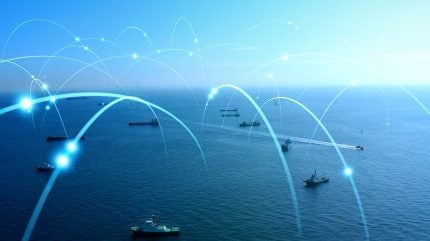
Digitalisation has been one of the biggest issues in the maritime for decades, with hundreds of companies attempting to bring the industry firmly into the digital age across all aspects of operations, from digital ship models to biometric cruise terminal check-ins and autonomous shipping.
Despite this, the industry has arguably played into its reputation as a slow-moving, tradition-focused sector and has struggled to keep up with implementing the interconnectivity innovations seen in other transport industries, such as rail and air travel.
This perhaps makes it an obvious idea for a company from a more successfully digitalised industry to bring its solutions across to the maritime world, leading aviation tech giant SITA to try its luck with SmartSea.
The “one-stop shop” company was launched in partnership with Columbia Ship Management in May 2024 and is hoping to leverage the digitalisation success achieved by SITA over its 75-year history with airlines and airports.
CEO Julian Panter spoke to Ship Technology about why SmartSea could be the company to finally accelerate the maritime industry’s adoption of digitalisation and what shipping companies can learn from aviation’s success.

Noah Bovenizer: There are so many companies trying to bring digital solutions to the maritime industry – what can SmartSea bring to the table and how will having SITA on board help?
Julian Panter: This is actually exactly what I’m hearing from a lot of the high-level leadership personalities that I know within the industry, as they’re saying: “Well, we’re doing our own thing now, we don’t need another technology company.” But what I’m trying to explain is that we’re not trying to be just another technology company, and this is what we’ve learned from SITA.
What SITA did, which was really novel back in 1949, was allow its company to be owned by the airlines and it didn’t try to go in and supersede the technology that already existed, to monopolise the industry. Instead, SITA ensured that all members of the industry, from airlines to airports and digital borders, communicated through standardised digital solutions to allow a free flow of digital language throughout the aviation ecosystem.
For example, when you check in at an airport, your passport and flight information will be sent to immigration in the same digital language, no matter which airline you use, thanks to SITA. This is why I call SITA the glue that sticks the aviation sector together, but you don’t have that in maritime.
I said that the aviation industry was 10 or 15 years ahead of maritime, but now I think it’s actually probably further ahead than that.
In fact, digitally, ships don’t talk to ports at all, it’s all done through human interaction on radios, or if you look at something like bills of lading, the majority of that process is still done on paper, which is crazy.
When we started SmartSea three or four months ago, I said that the aviation industry was 10 or 15 years ahead of maritime, but now I think it’s actually probably further ahead than that. This isn’t because the aviation industry is ahead on the individual bits of technology, but I think it is decades ahead on the unification of the sector.
I think what’s very interesting about SmartSea is that there’s nothing like us out there. Most of the maritime technology companies are either startups with a bit of private equity, or it’s an idea for a piece of technology that someone’s come up with, or shipping companies will start almost an internal technology department that only really serves them. I don’t think there’s anything like SmartSea where it’s a big powerhouse technology company coming into maritime and trying to replicate what it has done in a different industry.
NB: Why do you think the maritime industry has been so slow to adopt digitalisation, especially compared to other transport industries?
JP: Firstly, let’s not forget that the maritime industry is thousands of years old, so it’s developed a lot of historical cultural behaviours from a long time before digitalisation even existed and companies, organisations, and ports have developed their own ways of doing things, their own processes.
If you look at aviation, which is a much newer industry, it was able to grab hold of the uptick in technology versus the uptick in the industry as it’s easier to try and implement technologies into a newer industry.
I think that’s probably where we’ve got a problem in maritime as we’re changing the culture and the mindset of an industry that’s very old. If you built the industry right now, of course, you would link everything up with technology, without question. But I think when you’re dealing with legacy and you’re dealing with historical cultural factors, it’s difficult to change these mindsets.
For example, when we speak to some of these really old shipping companies, it’s difficult for them to grasp the concept of sharing data, but it’s not to say that these individual big shipping companies, like the Maersks and the Hapag Lloyds, are not all investing in these technologies, it’s just there’s a lack of glue that sticks it all together.
NB: What exactly will SmartSea be offering to the industry that differs from the existing technology out there?
JP: Well, obviously we’ve got a juggernaut of a company behind us in SITA, so we’re very different in the fact that we’re not a maritime technology company that’s sprung out of one of the larger shipping companies – we’re coming from an industry that is ahead of maritime.
This makes us unique from the beginning, as we’re bringing a very different flavour of experience. We’re also 49% owned by Columbia Ship Management, which has 450 vessels [in its fleet], so we’ve got a canvas to work with and one of the investments that we’re looking at is creating a much more advanced intelligent management platform for those vessels.
The other thing that SITA does, which we want to try and bring over from aviation, is IT management outsourcing. If you can imagine how advanced SITA’s IT outsourcing capabilities are from working in the complex environments of airports like Heathrow in the UK, just think about how much value SmartSea could leverage from that to take to the offices of big organisations like Maersk or MSC.
Columbia has even already given us all its IT outsourcing and said to us “We want you to look at our cyber security, how we manage our hardware, how quick our Internet access is, etc.”
Then the other bits of the jigsaw are the general technology services that we can offer the industry. This is where it’s really interesting because think about checking in at an airport now, you can go through an e-gate and a biometric screening, and you’re in the duty-free area about six minutes after arriving at the airport.
Why can’t we start looking at some of what the aviation sector is doing and start plugging it in?
Well, we’ve got cruise terminals around the world where people are still waiting on the quayside for hours, faffing around with bits of paper in the heat of the sun or in the rain and the cold. So why can’t we start looking at some of what the aviation sector is doing and start plugging it into the infrastructure of shipyards or ports or digital marinas? This is the sort of technology that we’re going to try and leverage from SITA because it has a treasure chest full of digital solutions.
So I’d say the three core elements of our business will cover every part of the industry and the value chain and, in the short term, my aim as the CEO of SmartSea is to try and get those three elements up and running. We’ll obviously be using Columbia as our anchor client, but we’re also trying to get business with other shipping companies, cruise companies, ports, and shipyards.
Then, the long-term game that we want to try and learn from SITA is this ability to unify the industry and work with the IMO and other governing bodies on unification. Later on, we also might share some of the ownership of SmartSea with the industry so they can all buy into it, and partner with other technology companies to show them that we’re not trying to replace them, we’re trying to build ‘middleware’ to enable cross-platform dialogue.
NB: SITA has been working almost exclusively in aviation for decades. What pushed the move into the maritime industry?
JP: That is the same question I asked SITA when I first came in. Clearly it’s primarily an aviation company. But I think what SITA realised is that with its IP, and this knowledge of the need to join up different forms of travel and logistics, it already had one side of the coin, and the technology needed to create intermodal forms of travel.
Then the other element of it was that some of the industry in maritime had organically started to work with SITA already. For example, companies like Hapag-Lloyd wanted some support within its shore-based offices, and the Ministry of Transport in Singapore had said: “If you can do this [security] in the airport, can you do it in a cruise terminal?”
So there was a natural business growth into a different sector, just from SITA being good at what it does in aviation and the existing links between the two industries.
This article was originally published in our digital magazine, Ship Technology Global. You can subscribe to the magazine for free by clicking here.



